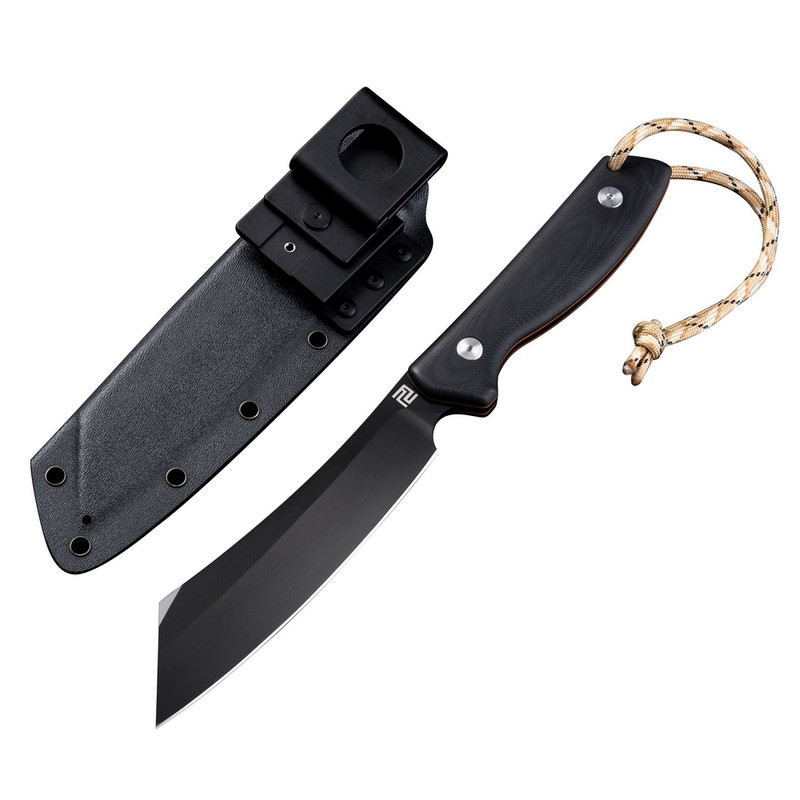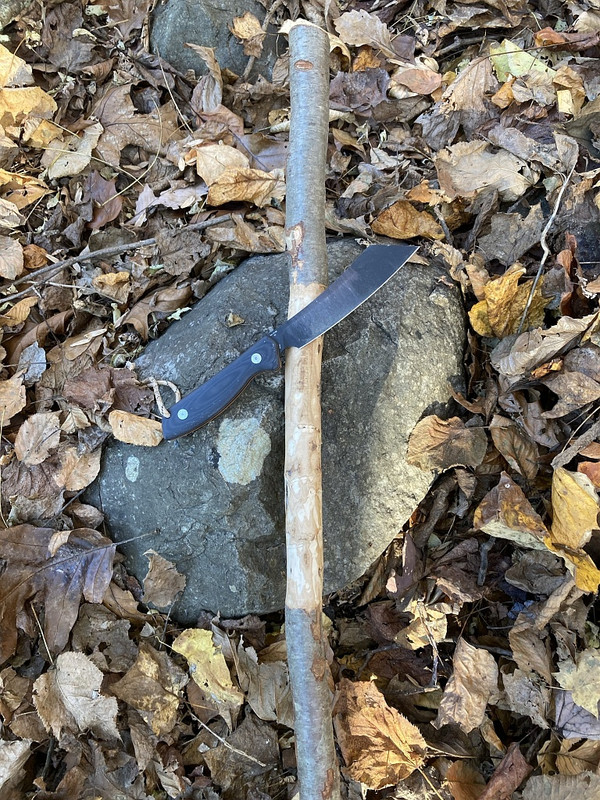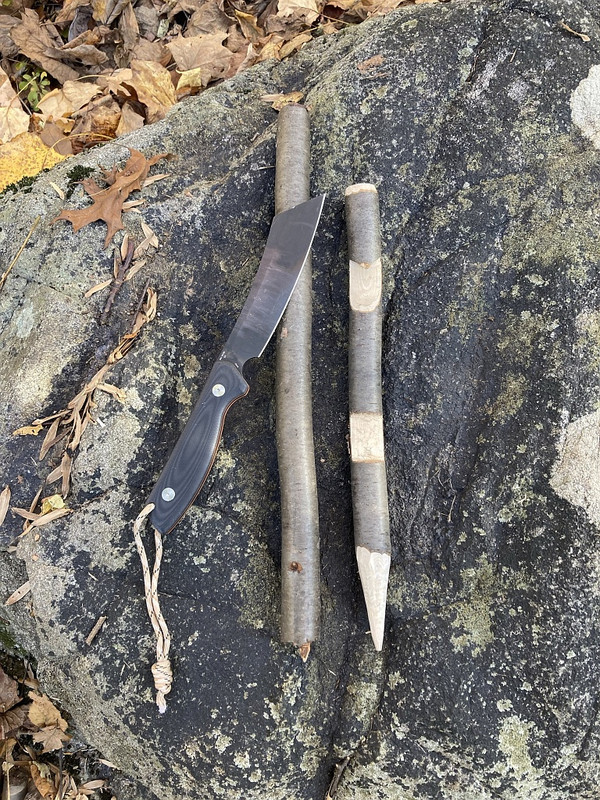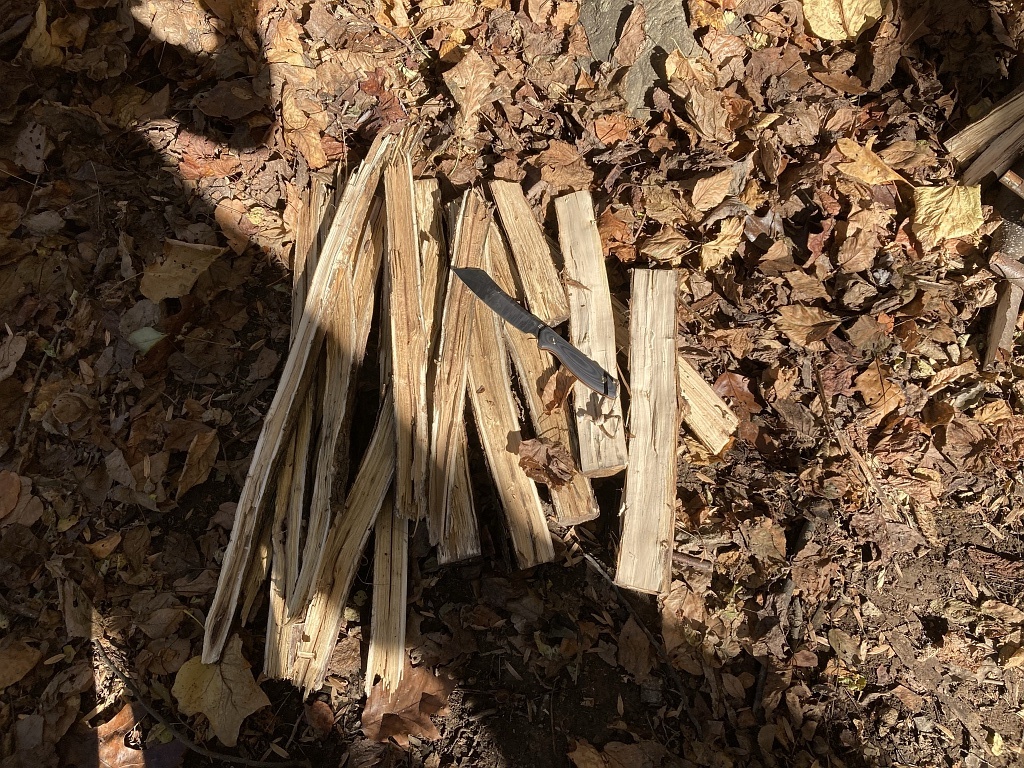
* Blade Length: 6.30"
* Blade Thickness: 0.15", 3.8mm (in reality it's closer to 3/16th's, 4.5mm)
* Blade Finish: Black Coated
* Blade Grind: Flat (in reality it's a high saber)
* Blade Material: D2
* Blade Hardness: HRC 59-61
* Blade Style: Drop Point (in reality it's more of a sheepsfoot)
* Sheath: Kydex with a stainless steel clip (in reality the clip is plastic)
* Overall Length: 11.4"
* Handle Material: G10
* Weight: 15.9oz
* Price: $90
Those specifications were taken directly from the manufactures website, as you can see by some of my comments their accuracy is a bit questionable. Three times in the first two paragraphs I've used that word, this review seems to be drifting a bit into the uh-oh zone.
At $90 the Tomahawk is $30 less than when I bought it at the end of 2022. How many things drop in price today? Maybe we're veering back in the right direction now? Who knows. There's a roughly 1 inch finger choil in the ricasso, making the usable cutting edge of the blade around 5.5". Where the ricasso meets the blade sharpened edge it's angled slightly away from your finger, maybe not quite enough if you have XL hands like I do. Twice during my day in the woods I nicked my finger and ended up with a tiny cut. It's something easily fixed though, a minute or two with a metal file and I was able to round off the edge and eliminate the problem permanently.
Artisan Cutlery claims the Tomahawk is a drop point but that wouldn't be my definition, I'd classify it as more of a sheepsfoot instead. A more drastic drop off than the typical sheepsfoot perhaps, but it's not a drop point in my opinion. Frankly, the overall profile strikes me to be that of a mini parang. That's part of the reason I bought this knife in the first place, I tend to consider the traditional parang a nice multi-function blade profile.
The handle scales are made from G10 with your choice of liners; white, red or orange (which is what I opted for). They're held in place with stainless steel Corby bolts. The scales themselves are a bit thin, sanded smooth and slab side. No "Coke bottle" shape here. That combination means the knife can sometimes move around a little in your hand when working it hard, especially if you have sweaty palms.
It's not all bad news however as the main body of the handle is pretty tall in the top-to-bottom dimension, that does help offset the thin/slick scales to an extent. At just over 5" long the handle can accommodate choking back, so long as you don't have paws the size of Andre the Giant of course. There's a finger recess/guard at the front which helps lock your hand in place. The remainder of the handle basically mirrors the shape of the blade itself, with a long sweeping arc. It's almost as though it was styled as well as designed. It is a somewhat unusual shape though so my initial fear was it might not be comfortable, but it turned out to be fine. Sometimes difficult to hold onto with really dirty hands, but there were no hot spots at all.
The sheath is a taco-style Kydex unit with a drain hole on the back. It's quite small making it an easy carry on your belt. It's precision molded to the knife, but in this case perhaps to a fault. In theory a tight knife-in-sheath fit is a good thing, but with the Tomahawk it was so taut as to make it difficult to draw one handed. That problem was exacerbated by the lack of a thumb ramp, more often than not I needed both hands to extract it. I've taken the Tomahawk in and out of the sheath several dozen times now but it hasn't loosened up much.
Artisan Cutlery states the sheath has a stainless belt clip, mine came with a plastic loop instead. It's a shade over 1.5" in width, if you use a 2" belt keep that in mind. Thankfully it isn't a closed loop design, you can take the knife on and off without undoing your belt. There are 6 mounting holes on the perimeter for mounting your own kit; add a ferro rod loop, a pouch, 550 cord, whatever else you might be compelled to take with you. There are actually 8 mounting holes in total but the belt loop consumes 2 of them. They aren't all equidistant however, you could potentially have challenges with some of your gear as they don't necessarily follow industry standard spacing.
According to Artisan Cutlery the Tomahawk weighs about a pound and is 11.4" in length. Before it arrived I had a certain image in my head about what it would be like, yet in the hand it was quite different. Instead of a largeish and somewhat heavy knife, it looked and felt decidedly smaller and lighter. I don't have a scale to weigh it on, but my tape measure says it's actually about 1/4" longer than the published spec's. From that it would seem to be a beastly knife, but it really isn't. Combined with the slender sheath the Artisan Cutlery Tomahawk is not unwieldy to use or carry, despite what the spec's might imply.
Unfortunately the spine is not sharpened. Some consider that useful only for a ferro rod, but for me it does more. For example, I use it as sandpaper to smooth off the hand hold sections of a walking stick...

To do that I make stop cuts around the circumference of the stick above and below where my hand will go. I then use the edge of the knife at a very low angle to slice off the bark. Once I have all the bark removed I shave off any major ridges. I then flip the knife over, position it at a 45° angle and start scraping away. Except for the last part, the Tomahawk worked very well for this task. It was easy to maneuver and sharp enough to deftly take off anything I wanted it to. Due to the high grind, and very sharp out-of-the-box edge, I could lay the knife down almost parallel to the stick and gently shave off any imperfections. While I do get better results from sharpened spine, the profile of the Tomahawk provided a very workable plan B.
With my walking stick done, and finally being in camp, it was time to make some try sticks. Mine are fairly simple; a couple of different notches, add a tent stake point to one end and trim the edges off the opposite end so it doesn't fray when hammered into the ground...

The Tomahawk was a satisfying tool for the job, easily accomplishing everything I asked of it. The cuts were clean, precise and easy to make. It doesn't hog off large chunks like a scandi would, but given this is a saber grind I suspect you probably already knew that. Personally I'm a fan of general purpose knives so that's just fine with me. The handle didn't cause any fatigue or make me count the minutes until I was done. I simply zoned out, went into my own world and carved away. I like doing that, it's cathartic.
After notching come battoning time. For me that's a must have capability for a knife, if I'm in the woods it's mandatory to have a fire. Preferably a big one. I carry a small folding saw, that and a knife is all I take with me. My firewood stash was low on this particular day so the Artisan Cutlery Tomahawk got quite a workout. I pounded away for 20-25 minutes, which doesn't sound like a long period of time until you're beating a knife through wood for that long. Here's the first 5 minutes or so...

The Tomahawk took a legitimate pounding that day, yet it held strong. The thick blade stock and high saber grind created an impressive wedge that plowed right through the wood. I didn't sense much in the way of shock being transmitted through the handle, it felt solid throughout. By the time I was done the black coating on the blade was starting to show some streaking, it was also getting thin on the spine where the baton was hitting it. That's to be expected however, no coating of any type lasts on a knife. I'm not sure why manufacturers even bother, it's not like it does much good.
As is my wont, when I get home from field testing a knife I use it to prepare a meal. The only thing I do is clean the blade, I don't sharpen it or perform any edge maintenance whatsoever. That night I had BBQ chicken breasts, rice and peas. The chicken was butterflied. The Tomahawk had no problem slicing cleanly threw the raw chicken, easily prepping it for the grill. Using this knife while eating dinner did require some concentration, not unexpected when you're holding a blade that's about a foot long and almost a pound. For me the best approach was to press my thumb on the side of the handle, place my index finger on top of the spine and then wrap my other 3 fingers around the belly of the handle. Arranged like that, it felt quite natural. You won't confuse it for a steak knife, but it ably does the job of one.
Out in the woods the Artisan Cutlery Tomahawk was enjoyable to use. The handle scales are smoothed in every imaginable way so there were no hot spots, no matter how long you hold it or what grip you use there won't be any blisters when you get home. My knife came out of the box very sharp and stayed that way throughout the day. By the time I got home it needed maybe a minute of stropping to bring it back to a factory fresh edge. I would favor the sheath retention not be quite so tight, but that's better than too loose in my opinion. The Artisan Cutlery Tomahawk is a unique and classy looking knife that performs very well.
